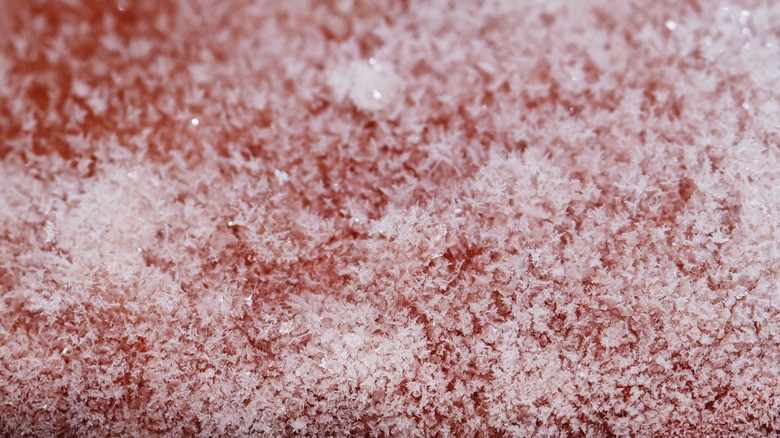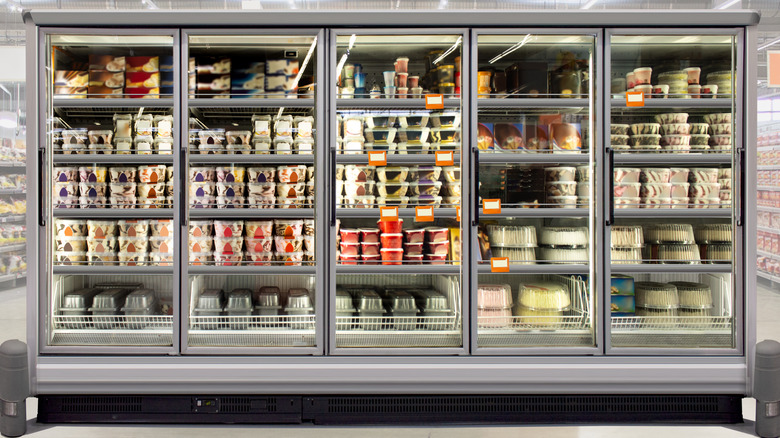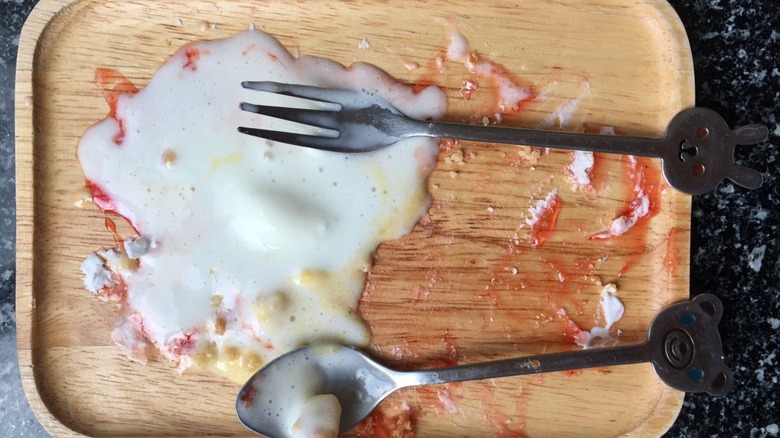11 Red Flags At An Ice Cream Shop That Should Make You Turn Around
Visiting an ice cream shop should be a joyful occasion — full of sweet promises and frozen delights. While that's certainly what we hope for at every ice cream parlor, sometimes inferior business practices can ruin the experience. With so many ice cream shops to choose from, it's hard to know if you're going to the best spot or just settling.
While some factors come down to preference, like if you have specific dietary requirements or are very loyal to a particular location, there are other ways to guide your decision. Not all ice cream shops take the same care in quality, service, and presentation.
Some shops might sell misleading products, while others aren't using appropriate storage methods. Hygiene and ingredient composition are also worth paying attention to, in order to guarantee an enjoyable experience. After all, there are many ice cream brands available at the grocery store that will satisfy your sweet tooth if your local scoop shop isn't up to par. Here are some red flags you should look out for on your next trip to an ice cream shop; if you see any of them, you'll be better off going to the supermarket for your frozen confection fix.
1. Crystals on the ice cream's surface
Ice cream and other frozen desserts obviously belong in the freezer, but there is a limit to how long they can be stored, as well as optimal ways to preserve their quality. Freezer burn is a surefire way to ruin a frozen treat. This occurs when a food's moisture decreases due to dehydration, and worsens with exposure to oxygen if the surface isn't properly covered. Unfortunately, ice cream has a pretty hefty water content of around 60%, meaning it's a prime culprit for this outcome if incorrectly stored.
Can freezer-burned food make you sick? The short answer is no — as long as the freezer has maintained an appropriate temperature, there's no food safety issue with eating freezer-burned food, like poorly stored ice cream. However, it's certainly not worth paying for that if the taste and texture are compromised. If ice cream is freezer-burned, its deliciously creamy consistency is replaced with a grittiness due to the presence of ice crystals, while the taste can be stale.
You don't need a magnifying glass to identify freezer burn on ice cream; just look out for ice crystals covering the surface of the trays behind the display glass. Ice cream should appear smooth and creamy, signaling the richness and luscious melt-in-your-mouth quality awaiting beneath.
2. Misleading product labels
Advertising often takes advantage of the fact that people are drawn to certain words and descriptions when making purchasing decisions. Unfortunately, although there are strict regulations regarding what can and can't be labeled as ice cream, some vendors might lean into creative license when describing their products.
Ice cream needs to contain at least 10% milk fat and a minimum percentage of nonfat milk solids, with various stipulations regarding ratios in the presence of flavoring ingredients. Otherwise, it falls into the realm of frozen desserts. A wide range of other dairy products can also be included, as well as natural and artificial variations of fruits, nuts, and vanilla (to be labeled as natural or artificial flavorings). Of course, it's easy for an ice cream shop to leave the word "artificial" in the fine print, while indicating the fruit flavor in large lettering on the menu board.
Meanwhile, a shop selling "artisanal" ice cream is sure to pique consumer interest. This label refers to small-scale production that contains no preservatives and prioritizes fresh, seasonal, and local ingredients. That's great in theory, but the U.S. Food Safety and Inspection Service does not regulate this term, meaning that any shop can claim to sell artisanal products. Because of this, it's worth asking shop employees if their "artisanal" ice cream is indeed handmade in small quantities.
3. Use of the same scoop without rinsing between tubs
Allergies and intolerances range from minor to serious, but it's not the kind of thing to take lightly if you're running a business involving food. Next time you're getting a cone at your local shop, you'll want to check that the employees are properly rinsing the scoop between flavors. We're not talking about just quickly dipping the utensil in a tub of milky water. We're talking about actually rinsing the scoop in fresh running water, whether it's a sink or a specific appliance. Even better, ask staff to use a clean scoop to decrease the chances of contamination.
Besides allergies, if proper hygiene isn't respected at the shop, you can bet that all of the flavors contain traces of each other. Furthermore, the murky ice cream water — which will contaminate your scoops — can leave the wrong taste in your mouth. So, it's in your best interest to make sure the shop is using fresh water to clean the scoop.
4. A bad smell in the air
The last thing you want to experience when walking into an ice cream shop is a bad smell lingering in the air. You should be greeted with the aroma of waffle cones and the creamy treats behind the display glass. Apart from being unpleasant to deal with, a questionable odor can signal something less than ideal.
If the shop is also manufacturing ice cream on-site, the process creates several waste byproducts, including compounds that can cause unpleasant aromas. More importantly for your delicate nose receptors, one of the main elements is hydrogen sulfide, which smells like rotten eggs. That's certainly not a welcoming odor when you walk into an ice cream shop, and it's an immediate red flag that should have you turning around at the door. While this isn't a regular occurrence, it's a clear sign that waste management does not meet appropriate standards for food safety.
5. The shop only sells generic or economy-grade products
If you're going out of your way to treat yourself at an ice cream shop, you don't want to be served an ordinary product that anyone can get at the grocery store ... or worse, subpar ice cream. Unless you're specifically visiting a quality producer that sells its desserts in both dedicated shops and supermarkets, like Jeni's Ice Cream or Ben & Jerry's, chances are you'll be underwhelmed if the new shop down the street is scooping store-bought Blue Bell.
Aside from the regulations defining ice cream vs. frozen dessert, distinct quality levels also come into play. Ice creams are classed in economy, standard, premium, and super-premium categories depending on fat content and other ingredients, providing the consumer with another metric to understand the product they are purchasing. If you're spending money on a cone from an ice cream shop, it had better be premium or super-premium — otherwise, you might as well just grab a carton from the corner store.
So how can you tell? Super-premium ice cream features excellent ingredients and unique flavors, along with the highest fat content and the lowest overrun. (Overrun is a measure of the amount of air whipped into the product, and the less of it you have, the creamier and richer the result.) Economy-grade ice cream has the maximum permitted amount of overrun, appearing voluminous but ultimately containing a much higher ratio of air to substance. Hopefully your chosen parlor will serve the good stuff.
6. Employees can't tell you the ingredients
It's not a good sign when ice cream shop employees appear oblivious to what they're selling. Whether they're entirely uninterested or the list of artificial flavorings and dyes is too long to remember, it doesn't bode well for the quality of the product. The best ice cream shops have a team of enthusiastic employees who actually care about the product they're scooping. Furthermore, to comply with U.S. Food & Drug Administration regulations, ice cream labels need to indicate the ingredient content and fit with certain requirements.
You may not find that information in immediate view at your local ice cream parlor, depending on the shop layout and other factors, but it should be present or within easy reach. Aside from the customer's right to know what's in their scoop in order to make nutritional decisions that suit their needs, allergies are an obvious concern. While common allergens like peanuts might be marked, there are many other potential triggering ingredients that many people will want to avoid.
7. The interior is littered and the display case isn't clean
Any food establishment should pay extra attention to hygiene, and that shouldn't just be limited to the kitchen. Public areas, tables, and display cases should be just as clean, even if food isn't being prepared in these spaces. Although ice cream shops can become hectic in the peak of summer, staff should be able to keep up with overflowing trash cans, sticky tables, and fingerprint-covered glass displays.
While it's natural for ice cream shops to be overloaded when it's hot outside, placing extra strain on employees, a well-managed establishment should account for cleanliness. If the shop isn't taking care of the areas that are visible to customers, there's no telling what the back-of-house facilities look like. Unhygienic conditions and improper food handling can make it easier for bacteria to proliferate, which can lead to food contamination and cause food poisoning symptoms. Don't stick around to find out for yourself.
8. All the products look artificially colored
There's a place for bright fluorescent colors, but as far as we're concerned, it isn't in the freezer display at an ice cream shop. Unnatural hues scream out with the presence of artificial colorings, and U.S. regulators aren't exactly known for placing all that many restrictions on these chemicals. When you're looking for a quality scoop, red dye No. 3 doesn't really fit into the picture.
By the time you combine fruit with dairy components to make ice cream, it's normal for the color to become more subdued. Even if you start with bright red strawberries, the result will be pink once you mix the puree or juice with a creamy white dairy base, not fire-truck red. Similarly, coloring-infused pistachio ice cream looks like it had an encounter with The Hulk, when the natural tint is more on the pastel spectrum.
Vibrant foods attract our attention, and doubly so if you've got children in tow. There's nothing more exciting than a rainbow scoop for kids, making it all the more tempting to use artificial colors if the priority is profit rather than flavor. A study published by BioMed Central demonstrated that intense colors in edible products can also alter consumer perceptions, such as giving the impression that foods are sweeter than they actually are. Although you'll be more visually stimulated by the bright stuff, confusing your taste receptors in the process, artificial flavors and dyes certainly can't beat real-deal quality.
9. Soft-serve machines aren't regularly cleaned
Soft-serve ice cream is a special kind of confection, shaped into a dazzling swirl that is ever so delightful to consume. This format requires a specific machine that needs to process the cream base to produce each cone. As you might imagine, that machine has plenty of nooks and crannies that need to be regularly — and properly — cleaned. Unfortunately, that might not be the reality when a shop is busy, or staff members are not appropriately trained.
Cleaning an appliance one to two times daily is just one more chore in a busy workday, and it's easy to imagine that the machine might just get a perfunctory wipe-down if employees are overwhelmed with clients. Unlike a countertop or basic prep area, cleaning a soft-serve machine can be fairly complex and require disassembly and reassembly, as well as specific sanitation products.
It might not be easy to assess the cleanliness of a shop's soft-serve machine, but if the establishment is waving any other hygiene red flags, it's best to avoid it entirely. Improperly cleaned machines can harbor dangerous bacteria.
10. No seasonal flavors or variations
Even fast-food chains spruce up their menus with rotating items or limited-time seasonal treats. An ice cream shop that prioritizes its craft should be enthusiastic about experimenting with new and seasonal flavors. Some regions are known for uncommon ice cream flavors that only appear briefly during the peak of a fruit harvest, before disappearing for the rest of the year as quantities dwindle. As a culinary product, great ice cream should follow the agricultural goods available in a given area.
Ice cream shops that stick to a basic menu that never wavers are missing out on the opportunity to experiment with new flavors. Not to mention, there's no better way to keep consumers coming back than by surprising them with novel flavors. Unless your local scoop shop has completely mastered the art of simplicity, doling out the best vanilla and chocolate ice cream you've ever tasted, it isn't worth visiting places that aren't making use of interesting ingredients to capture their customers' intrigue and titillate their taste buds. You might as well pick up a pint from the supermarket.
11. The store is empty despite a great location
Appearances aren't everything, but it can be telling if an ice cream shop boasts an enviable location, yet regularly sits empty. There are several factors to consider when selecting the right place for an ice cream shop. If needs to be someplace accessible, ideally close to places where people gather during spring and summer (parks and beaches are great), where there's a decent amount of foot traffic. People will travel for the good stuff, but they need to know it exists at their destination.
While competition might be partly to blame, there's bound to be a reason if people are skipping a convenient location and going elsewhere. Ice cream isn't a hard sell in the summertime. If a shop has everything going for it, but the lovely patio area remains empty on a Saturday afternoon in July, something's up. Unless you have reason to believe it's just circumstantial or a matter of gaining new customers in an area with other scoop shops, you're better off avoiding it too.











